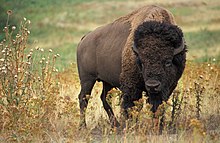Bison
Bisons are large, even-toed ungulates. They are bovines, and are similar to cows. They are often called buffalo, but are not closely related to the African buffalo or water buffalo.
| Bison Temporal range: Early Pleistocene – Recent
| |
|---|---|

| |
| American bison (Bison bison) | |

| |
| European bison (Bison bonasus) | |
| Scientific classification | |
| Domain: | Eukaryota |
| Kingdom: | Animalia |
| Phylum: | Chordata |
| Class: | Mammalia |
| Order: | Artiodactyla |
| Family: | Bovidae |
| Subfamily: | Bovinae |
| Subtribe: | Bovina |
| Genus: | Bison Hamilton Smith, 1827 |
| Species | |
|
B. bison | |

Bison live in the northern part of the world. The American bison lives in North America where they once wandered around the prairies in huge herds. The wisent lives in Europe. Bison can also live in rugged areas.
American
changeThe American bison is the biggest mammal in North America.[1] There used to be as many as 30 million bison in the United States, but because of hunting, by 1890, only 1000 bison were left.[2] Through conservation efforts, there are now more American bison than there used to be, but still far fewer than there were before the 1800s.
European
changeEuropean bison (wisent) tend to live in lightly wooded to fully wooded areas and areas with increased shrubs and bushes, though they can also live on grasslands and plains.
Taxonomy
changeThey are classified in the subfamily Bovinae of the family Bovidae.
- Genus Bison
- American bison (Bison bison)
- Wisent or European bison (Bison bonasus)
Life
changeThey live to be about 20 years old and are born without their "hump" or horns, which both males and females have. After shedding their lightly colored hair, and with their horns, they are grown at 2 to 3 years of age, but males keep growing slowly until seven years. Adult bulls are very dominant in mating season. Adult bison usually have one or two baby bison.
References
change- ↑ Gifford, Clive; Lisa Clayden (2002). Family flip quiz geography. Bardfield Centre, Great Bardfield, Essex, CM7 4SL: Miles Kelly Publishing. ISBN 1-84236-146-5.
{{cite book}}: CS1 maint: location (link) - ↑ Conger, Cristen (2 October 2008). "What brought bison back from the brink of extinction?". HowStuffWorks.com.